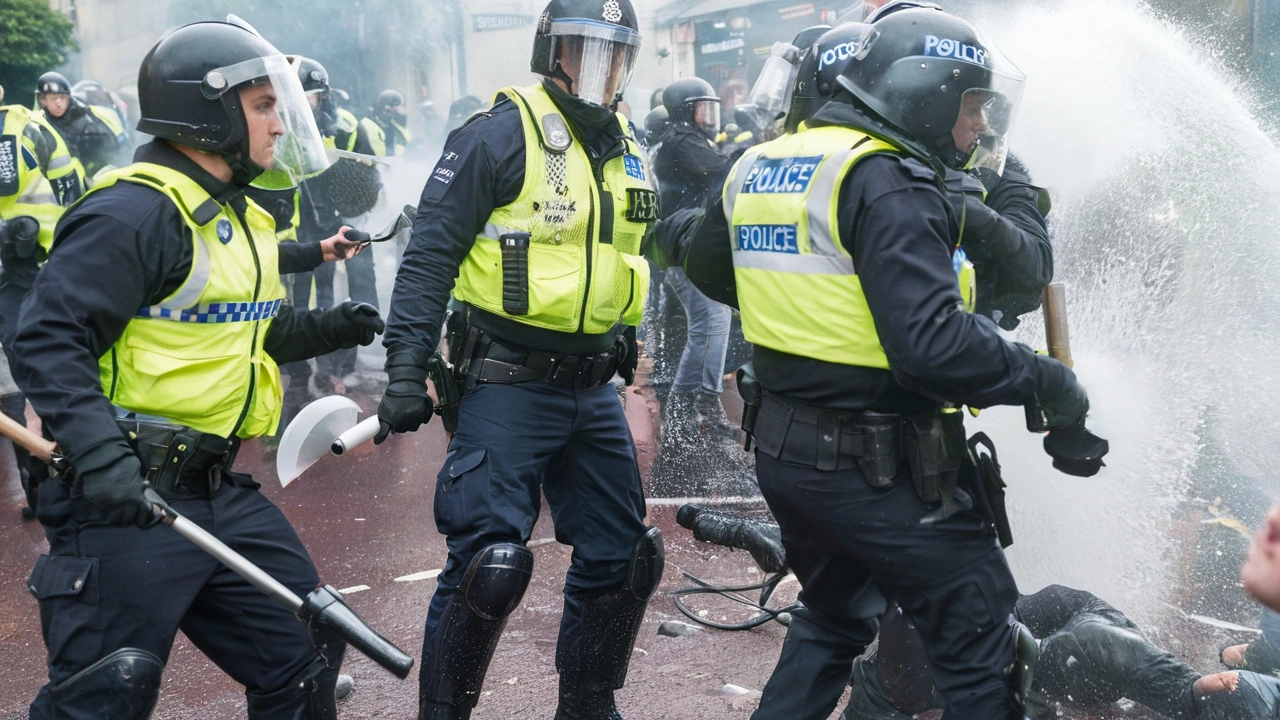Surge in Far-Right Street Violence Poses Challenges for UK Police
Across various towns and cities in the UK, a concerning surge in far-right fueled street violence is putting immense pressure on police resources. This escalation, sparked notably by a recent stabbing incident, has resulted in widespread chaos and has significantly stretched the capacities of law enforcement. The need to address these violent clashes while simultaneously managing routine criminal activities is creating a precarious situation for the police force.
The dilemma facing the police is multi-faceted. On one hand, they are required to quell the ongoing street violence, a task that demands immediate and intensive resource allocation. On the other hand, they must continue their usual duties, such as investigating burglaries, pursuing fraud cases, and dealing with domestic violence incidents. This dual pressure is leaving many departments stretched to their limits.
Impact on Regular Policing Activities
The surge in violence linked to far-right groups is not just a public order issue; it is a significant drain on police resources. With more officers being diverted to manage these street confrontations, there are fewer available to respond to other criminal activities. This is particularly problematic in areas already grappling with understaffed police forces.
Victims of other crimes, ranging from petty theft to more serious offenses, may find themselves facing delayed responses due to the current prioritization of street violence incidents. The need to maintain a visible police presence to deter further violence also means that officers are being pulled from their regular patrol routes. This shift not only reduces the capacity to respond to ongoing crimes but also affects preventative measures that are crucial to community safety.
Challenges in Resource Allocation
Police departments are working tirelessly to balance these competing demands. The challenges inherent in resource allocation are becoming increasingly evident as the rise in street violence necessitates quicker mobilization of officers and the implementation of crowd control measures. Moreover, the aftermath of these violent encounters often requires a significant amount of additional work, including gathering forensic evidence, interviewing witnesses, and providing support services to victims and their families.
Handling the fallout from this violence is a time-consuming process that diverts critical resources from other areas of policing. Victim support services, which include counseling and protection, are essential yet resource-intensive aspects of post-incident care. Amidst these challenges, departments are constantly faced with decisions on the most efficient deployment of their limited resources.
Psychological Impact on Officers
Another critical aspect often overlooked is the psychological toll on the police officers themselves. Being on the frontlines of such violent confrontations can lead to heightened stress and emotional exhaustion. Police forces must consider the mental wellbeing of their personnel, who are operating under these intense pressures. Providing adequate mental health support for officers is essential, but it also adds another layer to the resource strain.
While addressing the immediate requirements of public safety, it’s imperative that police forces do not neglect the long-term wellbeing of their officers. This involves ensuring that they have access to mental health support and sufficient downtime to recover from the stresses of dealing with violent disturbances. Balancing these needs with the continual demands of public safety presents a significant logistical challenge.
Strategies for Improvement
Some strategies are being proposed to mitigate the strain on police resources. One approach involves increasing community policing efforts to build stronger relationships between law enforcement and local communities. This can help in early identification and intervention in potential conflict situations before they escalate into violence.
Enhanced intelligence gathering and monitoring of far-right groups are also crucial. By better understanding the networks and motivations behind these groups, police can take preemptive actions to prevent violent outbreaks. Collaboration with social services and community leaders can play a pivotal role in these efforts. By working together, they can address some of the root causes of extremism, such as social disenfranchisement and economic inequality.
In addition to these community-based approaches, there’s a call for increased funding and resources for the police. This could allow for the hiring of additional officers and the provision of more extensive training programs focused on dealing with violent extremism. Such measures would help to alleviate the pressures currently being experienced by police forces across the country.
Conclusion
The rising wave of far-right street violence in the UK presents a complex challenge for law enforcement agencies. Balancing the need to control public violence with the obligation to manage other criminal activities requires a strategic approach that maximizes limited resources. Addressing both the immediate impacts and the underlying causes of such violence is crucial for ensuring long-term public safety and the effective functioning of police forces. Both increased funding and a stronger focus on community collaboration are needed to address the dual pressures faced by police amid these turbulent times.


suresh sankati
August 7, 2024 AT 12:14Also, why is it always the cops’ job to fix society’s broken wiring? We’re out here buying TikTok trends while they’re out here dodging bricks.
Pooja Kri
August 8, 2024 AT 05:46Sanjeev Kumar
August 9, 2024 AT 23:27It’s about fewer reasons for people to hate each other
Every riot is a scream from someone who felt invisible for too long
And we keep sending uniforms instead of counselors
Maybe we’ve confused control with care
And now the whole system is screaming back
They don’t need more batons
They need more bread
More books
More belonging
Hemlata Arora
August 10, 2024 AT 03:25manohar jha
August 11, 2024 AT 09:38